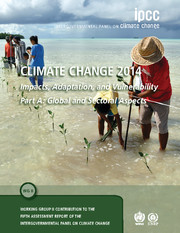 Climate Change 2014 – Impacts, Adaptation and Vulnerability: Part A: Global and Sectoral Aspects
Climate Change 2014 – Impacts, Adaptation and Vulnerability: Part A: Global and Sectoral Aspects Book contents
- Frontmatter
- Contents
- Foreword, Preface, and Dedication
- Summary for Policymakers
- Technical Summary
- Cross-Chapter Boxes
- Chapters 1-20
- Chapter 1 Point of Departure
- Chapter 2 Foundations for Decision Making
- Chapter 3 Freshwater Resources
- Chapter 4 Terrestrial and Inland Water Systems
- Chapter 5 Coastal Systems and Low-Lying Areas
- Chapter 6 Ocean Systems
- Chapter 7 Food Security and Food Production Systems
- Chapter 8 Urban Areas
- Chapter 9 Rural Areas
- Chapter 10 Key Economic Sectors and Services
- Chapter 11 Human Health: Impacts, Adaptation, and Co-Benefits
- Chapter 12 Human Security
- Chapter 13 Livelihoods and Poverty
- Chapter 14 Adaptation Needs and Options
- Chapter 15 Adaptation Planning and Implementation
- Chapter 16 Adaptation Opportunities, Constraints, and Limits
- Chapter 17 Economics of Adaptation
- Chapter 18 Detection and Attribution of Observed Impacts
- Chapter 19 Emergent Risks and Key Vulnerabilities
Chapter 16 - Adaptation Opportunities, Constraints, and Limits
Published online by Cambridge University Press: 05 January 2015
- Frontmatter
- Contents
- Foreword, Preface, and Dedication
- Summary for Policymakers
- Technical Summary
- Cross-Chapter Boxes
- Chapters 1-20
- Chapter 1 Point of Departure
- Chapter 2 Foundations for Decision Making
- Chapter 3 Freshwater Resources
- Chapter 4 Terrestrial and Inland Water Systems
- Chapter 5 Coastal Systems and Low-Lying Areas
- Chapter 6 Ocean Systems
- Chapter 7 Food Security and Food Production Systems
- Chapter 8 Urban Areas
- Chapter 9 Rural Areas
- Chapter 10 Key Economic Sectors and Services
- Chapter 11 Human Health: Impacts, Adaptation, and Co-Benefits
- Chapter 12 Human Security
- Chapter 13 Livelihoods and Poverty
- Chapter 14 Adaptation Needs and Options
- Chapter 15 Adaptation Planning and Implementation
- Chapter 16 Adaptation Opportunities, Constraints, and Limits
- Chapter 17 Economics of Adaptation
- Chapter 18 Detection and Attribution of Observed Impacts
- Chapter 19 Emergent Risks and Key Vulnerabilities
Summary
16.1. Introduction and Context
Since the IPCC's Fourth Assessment Report (AR4), demand for knowledge regarding the planning and implementation of adaptation as a strategy for climate risk management has increased significantly (Preston et al., 2011a; Park et al., 2012). This chapter assesses recent literature on the opportunities that create enabling conditions for adaptation as well as the ancillary benefits that may arise from adaptive responses. It also assesses the literature on biophysical and socioeconomic constraints on adaptation and the potential for such constraints to pose limits to adaptation. Given the available evidence of observed and anticipated limits to adaptation, the chapter also discusses the ethical implications of adaptation limits and the literature on system transformational adaptation as a response to adaptation limits.
To facilitate this assessment, this chapter provides an explicit framework for conceptualizing opportunities, constraints, and limits (Section 16.2). In this framework, the core concepts including definitions of adaptation, vulnerability, and adaptive capacity are consistent with those used previously in the AR4 (Adger et al., 2007). However, the material in this chapter should be considered in conjunction with that of complementary WGII AR5 chapters. These include Chapter 14 (Adaptation Needs and Options), Chapter 15 (Adaptation Planning and Implementation), and Chapter 17 (Economics of Adaptation). Material from other WGII AR5 chapters is also relevant to informing adaptation opportunities, constraints, and limits, particularly Chapter 2 (Foundations for Decision Making) and Chapter 19 (Emergent Risks and Key Vulnerabilities). This chapter also synthesizes relevant material from each of the sectoral and regional chapters (Section 16.5).
To enhance its policy relevance, this chapter takes as its entry point the perspective of actors as they consider adaptation response strategies over near, medium, and longer terms (Eisenack and Stecker, 2012; Dow et al., 2013a,b). Actors may be individuals, communities, organizations, corporations, non-governmental organizations (NGOs), governmental agencies, or other entities responding to real or perceived climate-related stresses or opportunities as they pursue their objectives (Patt and Schröter, 2008; Blennow and Persson, 2009; Frank et al., 2011).
- Type
- Chapter
- Information
- Climate Change 2014 – Impacts, Adaptation and Vulnerability: Part A: Global and Sectoral AspectsWorking Group II Contribution to the IPCC Fifth Assessment Report, pp. 899 - 944Publisher: Cambridge University PressPrint publication year: 2014
- 9
- Cited by
